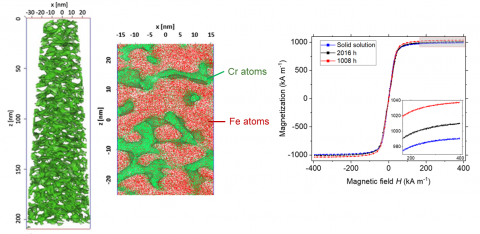Michalis Charilaou's new paper shows how magnetic properties can be used to probe degradation of steels
Wed, 08/24/2022 - 9:00am Iron-Chromium (Fe-Cr) alloys are the base of ferritic steels, which are vital materials for a wide range of applications and particularly important for future fusion reactors. When steels are exposed to high temperatures and radiation, however, microstructural modifications can occur that will compromise their structural integrity. It is therefore important to find a way to detect these microstructural modifications early on, in order to assess the strength of the metal. In a new article published in Acta Materialia, researchers from the ETH Zurich in Switzerland, the Forschungszentrum Juelich in Germany, and the Physics Department of UL Lafayette (Dr. Michalis Charilaou), have discovered that when structural degradation occurs in Fe-Cr, the modification of the alloy induces changes in its magnetic behavior, and therefore the magnetic response of these metals can be used as a proxy to assess their structural integrity. The researchers performed heat treatment of an Fe-Cr alloy for 2000 hours and using cutting-edge electron microscopy and atom-probe tomography techniques, as seen in the figure here, they were able to observe the modification of the microstructure. Under heat treatment, the alloy undergoes spinodal decomposition, where nanoscopic regions of Fe-rich and Cr-rich phases form, which can be seen as red and green points in the figure and each point represents a Fe and Cr atom, respectively. This change in microstructure, specifically the formation of highly magnetic Fe-rich regions, results in the substantial strengthening of the magnetic field (magnetization) in the material, and the change of the magnetic field relates directly to the change of the structural properties of the metal. This work therefore shows that in the future it might be possible to perform non-destructive testing of steel structures via magnetic means in order to assess their structural integrity.
Iron-Chromium (Fe-Cr) alloys are the base of ferritic steels, which are vital materials for a wide range of applications and particularly important for future fusion reactors. When steels are exposed to high temperatures and radiation, however, microstructural modifications can occur that will compromise their structural integrity. It is therefore important to find a way to detect these microstructural modifications early on, in order to assess the strength of the metal. In a new article published in Acta Materialia, researchers from the ETH Zurich in Switzerland, the Forschungszentrum Juelich in Germany, and the Physics Department of UL Lafayette (Dr. Michalis Charilaou), have discovered that when structural degradation occurs in Fe-Cr, the modification of the alloy induces changes in its magnetic behavior, and therefore the magnetic response of these metals can be used as a proxy to assess their structural integrity. The researchers performed heat treatment of an Fe-Cr alloy for 2000 hours and using cutting-edge electron microscopy and atom-probe tomography techniques, as seen in the figure here, they were able to observe the modification of the microstructure. Under heat treatment, the alloy undergoes spinodal decomposition, where nanoscopic regions of Fe-rich and Cr-rich phases form, which can be seen as red and green points in the figure and each point represents a Fe and Cr atom, respectively. This change in microstructure, specifically the formation of highly magnetic Fe-rich regions, results in the substantial strengthening of the magnetic field (magnetization) in the material, and the change of the magnetic field relates directly to the change of the structural properties of the metal. This work therefore shows that in the future it might be possible to perform non-destructive testing of steel structures via magnetic means in order to assess their structural integrity.
